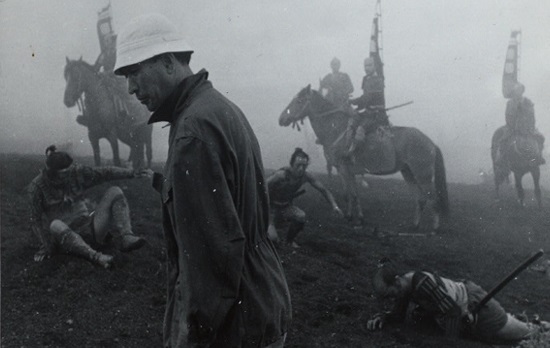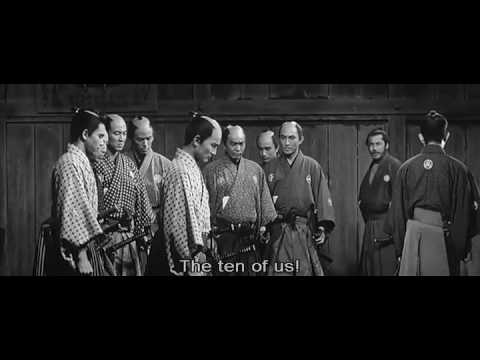Legendary Japanese director Akira Kurosawa’s samurai films have played a decisive role in the development of narrative cinema, but his contributions are as much a result of good timing as good filmmaking. His film Rashomon arrived in a post-war era when ‘world cinema’ as an idea was just being codified and Seven Samurai and Yojimbo quickly became enshrined as part of (if by no means typical of) that canon. These films were then devoured and dissected in film schools by the brat generation: Spielberg, Lucas, Coppola etc. and you can see Kurosawa’s fingerprints all over the most important innovations of the 70s and beyond. Seven Samurai was remade as The Magnificent Seven, The Hidden Fortress influenced the plot of Star Wars and Yojimbo was remade as a western (A Fist Full of Dollars), a gangster film (Last Man Standing) and even a surprisingly faithful adaptation with post-apocalyptic cyborgs (Omega Doom) among others. Yet, re-watching his core samurai films, recently released on Blu-Ray by the BFI, one can’t help but feel that Hollywood directors have gravitated toward only the most basic aspects of his work.
Firstly they of course, they lifted Kurosawa’s extraordinary camera work: long lenses which flatten the characters against painterly panoramas; economic shots containing just the right amount of information; quick, musical editing. This is the sort of technical prowess that George Lucas gushes about on the special features (if his sleepy delivery could ever be described as gushing), while simultaneously downplaying the plot influences of Fortress (“There are only about 30 archetypal stories, really.”.). But as innovative as Kurosawa’s filming of realistic action was, the path he blazed has its logical endpoint in the formalist insanity of Michael Bay – where everything, from characters and plot to general comprehension, is sacrificed in the service of the perfect sequence of shots.
It is sometimes neglected in the film brat narrative, just how good Kurosawa was at shooting stillness, slowness, rolling fog and awkward silences. Throne of Blood and Ran, his two Shakespeare adaptations, which drew on the heavily stylised Noh theatre tradition, are full of radically flat and static shots where the focus turns to the dialogue and the mask-like facial contortions of the actors.
Also, while Hollywood nicked the plotlines and revelled in the violence, they never quite captured the wantonness and amorality of his films. According to Kurosawa, after the 1923 earthquake which devastated Tokyo, his brother, a political leftist, took him to see the devastation, proclaiming that if he turned away from the scattered and charred bodies he would always be afraid. As is often pointed out, this ability to gaze unflinchingly at the horrible and grotesque is central to Kurosawa’s work, but what is also central is the idea of an unjust world in which natural disasters are blighted on an unsuspecting population.
Film critic Bert Cardullo makes the point that while European films are about psychology and American films are normally about heroism, Japanese cinema is concerned with circumstance. Rather than being plot drivers, Japanese protagonists are beset by tragedies (civil war, the break down of the feudal system etc.) and must make do with the lot they’re given, which is not necessarily the lot they deserve.
This is subtly different than the dark plots offered by westerns and especially film noir. Classic noir was famously constrained by the censorship schemes of the time, so that the bad guys always had to be punished in the end, and it still conforms to a very Christian kind of temptation and downfall premise. In Seven Samurai, who lives or dies has very little to do with honour or heroism, though there are acts of heroism none the less.
Even in The Hidden Fortress, which is for all practical purposes a swashbuckling romp, there is no particular justice or inevitability governing events. An aspect which is completely lost when translated into the orderly universe of Star Wars, in which fate and ultimately the fucking force is going to sort everything out. As a counter-example, Throne of Blood, being based on Shakespeare’s Macbeth, is all about fate – “when cobweb forest marches on cobweb castle ” – but this is a petty brand of fate, personified in the pale witch character, who visits chaos on the proceedings rather than order. The Macbeth proxy seems damned by the scenario he creates, not the choice he makes.
Good and bad are always elusive in Kurosawa films: think of how your sympathy constantly shifts between characters in his modern crime drama High and Low. During the War, Kurosawa was an establishment filmmaker making propagandistic films, but in its wake he did an excellent job of dismantling the romantic idea of the samurai code and honour, which had been misappropriated under Japanese fascism.
Yojimbo pokes fun at the samurai ideal through its oafish anti-hero (played by Toshiro Mifune) and at the samurai genre of films by parodying its conventions. Of his imitators, Leone probably best captured the cruelty of Kurosawa’s films. He did such a good job in the case of A Fist Full of Dollars that Toho pictures successfully sued him for the rights (seriously, the “the man with no name” uses his poncho like a baggy kimono). Clint Eastwood does an excellent impression of the cynical Mifune but his outlaw has more heart: he is more of a badass then actually ‘bad’. The Hollywood film maker who probably best captures the moral indeterminacy of Kurosawa is William Friedkin, who was also a fan.
For some viewers, one interesting discovery on the box set may be Sanjuro, the less famous sequel to Yojimbo. It’s a lot friendlier than it’s predecessor but no less skilful. This time Mifune’s character helps a motley crew of naïve samurai, but he’s less a father figure and more like an alcoholic dad exposing his kids to the worst parts of the world: he un-masks the corruption and treachery which their sense of duty blinded them to, and teaches them how to be cunning, manipulative and back handed.
In the special features, Sanjuro is also championed by an unlikely source in Repo Man director Alex Cox, who in his introduction is drawn to the “kill em all and let god sort it out” attitude of Kurosawa’s work. He especially draws attention to the [spoiler alert] climax of the film in which Mifune and his adversary face each other at either end of the frame for what feels like minutes before drawing swords in an explosion of blood. This daring device is far more extreme than any of the samurai genre films of the day and actually more tense than any of Leone’s squinty eyed stand offs.
Of the films on offer, the late period Ran is probably the most extreme in its relentless bleakness, but the vivid visuals (this is the only colour film on the collection) and apocalyptic action is certainly something which is worth seeing on Blu-Ray. Although it’s not included, it’s worth tracking down AK, Chris Marker’s wonderful documentary about the film’s production. While other directors wax lyrical about his camera work or storytelling, Marker typically talks about Kurosawa’s seeming obsession with horses and rain. It’s also great for behind the scenes shots of off-duty samurai wearing baseball caps and a fantastic scene, ultimately cut from the already lengthy film, in which a field of wheat is painted gold. This is a good example of both Kurasawa’s late period experimentation with symbolism and his colour photography, which is less evident in the samurai canon.
The film brats, who have done so much to define the language of film today, clearly owe a considerable debt to Kurosawa’s innovative Samurai films. But with each reappraisal of Kurosawa there is the opportunity that a new generation of film makers, perhaps more leftfield ones like Cox and Marker, will find different reference points, perhaps in Kurosawa’s modern-day (High and Low, Ikiru) and late period work (Dreams, Kagemusha). Yet there’s still a wealth of ideas left to be harvested in his classic samurai films if you can look past their considerable legacy.
The Akira Kurosawa Samurai Collection is available now on Blu-Ray from BFI



